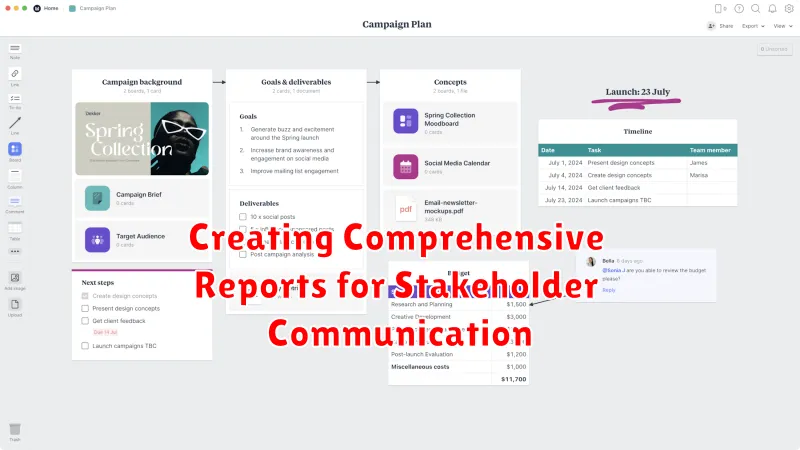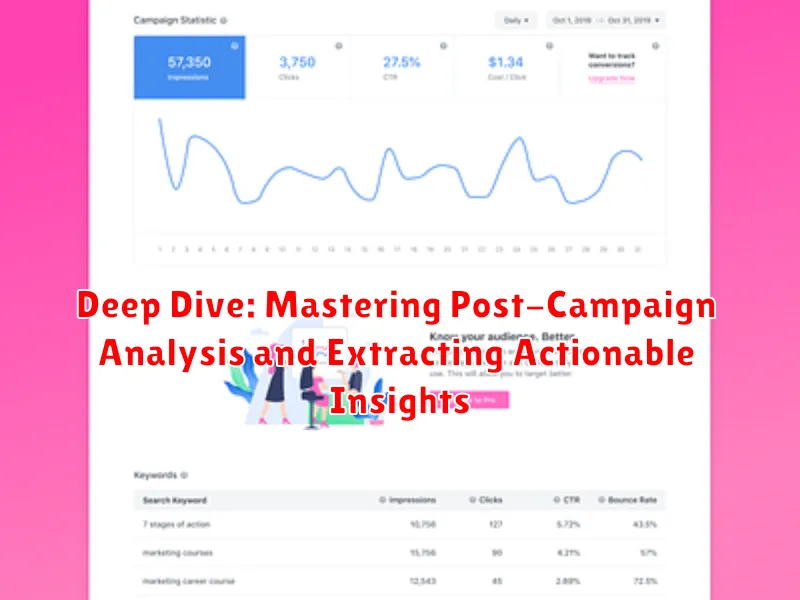In today’s competitive landscape, simply launching a marketing campaign isn’t enough. The true value lies in meticulously analyzing the aftermath: the post-campaign analysis. This crucial process allows marketers to dissect the performance of their campaigns, identifying both successes and shortcomings. A comprehensive deep dive into campaign data enables businesses to move beyond vanity metrics and extract actionable insights that can significantly improve future strategies and optimize resource allocation. This analysis forms the bedrock for data-driven decision-making, ensuring every marketing dollar spent contributes to tangible business results.
This article provides a comprehensive guide to mastering post-campaign analysis. We will explore the essential steps involved in collecting, interpreting, and leveraging campaign data to drive meaningful improvements. From understanding key performance indicators (KPIs) to employing effective analytical techniques, this deep dive will equip you with the tools and knowledge necessary to uncover hidden opportunities and mitigate potential risks. By focusing on extracting actionable insights, you can transform raw data into a strategic advantage, enabling your organization to achieve its marketing objectives and maximize return on investment.
Understanding the Importance of Post-Campaign Analysis
Post-campaign analysis is a critical process that extends beyond simply concluding a marketing initiative. It’s a deep dive into understanding what worked, what didn’t, and, most importantly, why. Neglecting this stage means missing out on invaluable opportunities for optimization and growth.
Consider post-campaign analysis as a learning loop. Each campaign provides a wealth of data. Properly analyzed, this data illuminates the effectiveness of various strategies, audience engagement levels, and the overall return on investment.
Without a thorough post-campaign review, future campaigns are built on assumptions rather than data-driven insights, leading to potential inefficiencies and wasted resources. Essentially, it’s the key to transforming past experiences into a roadmap for future success.
Key Metrics to Track in Post-Campaign Analysis
A thorough post-campaign analysis hinges on tracking the right key performance indicators (KPIs). Selecting the appropriate metrics ensures that insights are relevant and actionable, leading to improved future campaign performance. Here are some critical metrics to consider:
- Reach: The total number of unique individuals exposed to your campaign.
- Impressions: The total number of times your campaign was displayed.
- Engagement Rate: Measures the level of interaction with your campaign, including likes, shares, comments, and clicks.
- Click-Through Rate (CTR): The percentage of impressions that resulted in a click to your landing page or website.
- Conversion Rate: The percentage of clicks that resulted in a desired action, such as a purchase or form submission.
- Cost Per Acquisition (CPA): The cost associated with acquiring a single customer through the campaign.
- Return on Investment (ROI): Measures the profitability of the campaign.
Careful monitoring and analysis of these metrics provide a comprehensive understanding of campaign effectiveness and identify areas for optimization and improvement.
Tools and Techniques for Effective Data Collection

Effective data collection is paramount for accurate post-campaign analysis. The selection of appropriate tools and techniques significantly impacts the quality and comprehensiveness of insights derived.
Data Collection Tools
Various platforms offer robust data collection capabilities. Google Analytics is invaluable for tracking website traffic and user behavior. Social media platforms provide native analytics tools for monitoring engagement and reach. CRM systems (e.g., Salesforce, HubSpot) consolidate customer data, enabling holistic campaign performance assessment.
Data Collection Techniques
UTM parameters are essential for tracking the source of traffic to campaign landing pages. Implementing tracking pixels on key pages allows for the measurement of conversions and retargeting efforts. Surveys and feedback forms offer direct insights into customer perceptions and preferences.
Data Validation
Ensure data accuracy through regular validation checks. Implement data cleansing procedures to remove inconsistencies and errors. Establish clear data governance policies to maintain data integrity throughout the collection and analysis process.
Identifying Patterns and Trends from Campaign Data
Identifying patterns and trends within campaign data is crucial for understanding campaign performance and optimizing future strategies. This involves moving beyond surface-level observations to uncover deeper insights that reveal the underlying dynamics of your audience and marketing efforts.
Methods for Pattern Identification
- Segmentation Analysis: Divide your audience into segments based on demographics, behavior, and engagement levels. Analyze how each segment responded to the campaign differently.
- Time-Series Analysis: Examine campaign data over time to identify trends in engagement, conversions, and other key metrics. Look for seasonal patterns or changes in performance that correlate with specific events.
- Cohort Analysis: Group users based on when they were acquired or when they first interacted with the campaign. Track their behavior over time to understand long-term engagement and retention patterns.
Trend Visualization
Using data visualization techniques can significantly aid in identifying trends. Tools such as charts, graphs, and heatmaps can help to highlight significant changes and correlations within the data. Visual representation allows for quick interpretation and better communication of findings.
Turning Insights into Actionable Strategies for Future Campaigns
The true value of post-campaign analysis lies in its ability to inform and improve future marketing endeavors. This section outlines the process of converting gleaned insights into concrete, actionable strategies, ensuring each subsequent campaign benefits from past experiences.
Prioritize Key Findings: Begin by identifying the most impactful insights. What worked exceptionally well? What fell short of expectations? Rank these findings based on their potential influence on future campaign performance.
Develop Action Items: For each key finding, create a specific, measurable, achievable, relevant, and time-bound (SMART) action item. For example, if an insight reveals a particular demographic responded poorly to a specific ad creative, the action item could be “Redesign ad creatives targeting [demographic] with a focus on [alternative messaging] within the next two weeks.”
Implement Strategic Adjustments: Integrate these action items into your future campaign planning process. This may involve adjusting targeting parameters, refining messaging, reallocating budget, or experimenting with new channels.
Establish Testing Protocols: Utilize A/B testing to validate the effectiveness of implemented strategies. Continuously monitor key performance indicators (KPIs) to ensure adjustments are yielding the desired results and refine your approach as needed.
Analyzing Customer Behavior and Engagement Post-Campaign
Understanding how customers interacted with your campaign is crucial for future success. Post-campaign analysis allows you to dissect customer behavior and engagement levels, revealing valuable insights into what resonated and what fell flat.
Key aspects of this analysis include:
- Website Activity: Track page views, bounce rates, and time spent on key landing pages to assess user interest and navigation patterns.
- Social Media Engagement: Monitor likes, shares, comments, and mentions to gauge brand sentiment and campaign reach.
- Conversion Rates: Analyze the percentage of users who completed desired actions, such as making a purchase or filling out a form.
- Customer Feedback: Review customer reviews, surveys, and support tickets to understand their overall experience with the campaign.
By carefully examining these metrics, you can identify key drivers of customer behavior and optimize future campaigns for greater impact.
Common Pitfalls to Avoid During Post-Campaign Analysis
Post-campaign analysis is crucial, but certain pitfalls can render the process ineffective. Avoiding these mistakes ensures accurate insights and better future campaigns.
Common Mistakes
- Ignoring Data Cleansing: Analyzing inaccurate or incomplete data leads to flawed conclusions. Always ensure data is clean and reliable.
- Focusing Solely on Vanity Metrics: Prioritizing metrics like likes and shares over meaningful indicators like conversion rates provides a skewed view of campaign performance.
- Lack of Clear Objectives: Without defined goals, interpreting results becomes subjective and lacks direction.
- Insufficient Segmentation: Failing to segment the audience prevents understanding of diverse responses to the campaign.
- Delayed Analysis: Waiting too long to analyze data can make insights less relevant and actionable due to changing market conditions.
- Overlooking Qualitative Feedback: Focusing only on quantitative data neglects valuable insights from customer comments and reviews.
By proactively addressing these potential issues, organizations can extract more value from their post-campaign analysis efforts, leading to improved decision-making and enhanced marketing strategies.
Using A/B Testing Data for Post-Campaign Optimization
A/B testing, also known as split testing, is a crucial component of campaign optimization. Analyzing data from A/B tests conducted during your campaign provides valuable insights into what resonated with your audience and what didn’t.
Specifically, focus on identifying the winning variations. These are the versions of your ad copy, landing page, or email subject line that performed better based on your chosen metrics (e.g., click-through rate, conversion rate). Document the characteristics of these winning variations.
Apply these learnings by incorporating elements of the winning variations into your future campaigns. Discard or significantly revise elements of the losing variations. This iterative process of testing and refinement is key to continuous improvement and maximizing ROI. Here is an example:
- Subject Lines: Test different subject lines to optimize open rates.
- Call-to-Actions: Experiment with varying call-to-action wording and placement.
- Visuals: Compare the performance of different images and videos.
Creating Comprehensive Reports for Stakeholder Communication

Crafting comprehensive reports is crucial for communicating campaign results effectively to stakeholders. The report should provide a clear and concise overview of the campaign’s performance, key findings, and actionable recommendations.
Essential Components of a Stakeholder Report:
- Executive Summary: A brief overview of the campaign’s goals, strategies, and key results.
- Key Performance Indicators (KPIs): A presentation of the most important metrics tracked during the campaign, such as conversion rates, click-through rates, and return on investment (ROI).
- Data Visualization: Use charts, graphs, and other visuals to present data in an easily digestible format.
- Insights and Analysis: Provide context for the data and explain the significance of the findings.
- Recommendations: Outline specific, actionable steps that can be taken to improve future campaigns.
Tailor the report to the specific needs and interests of your audience. Consider using different formats, such as slide decks or dashboards, to present the information in the most effective way. Emphasize clear, concise language and avoid technical jargon that may be unfamiliar to your stakeholders.
Leveraging Post-Campaign Insights for Long-Term Growth
The true value of post-campaign analysis lies not only in understanding what happened, but in leveraging those insights to fuel sustained growth. By meticulously examining campaign performance, organizations can identify opportunities for long-term improvement and strategic advantage.
This involves several key areas:
- Refining Targeting Strategies: Use data on audience engagement and conversion to hone targeting for future campaigns, reaching more receptive customer segments.
- Optimizing Messaging: Evaluate which messages resonated most effectively and incorporate those learnings into future communication strategies.
- Improving Customer Journey: Analyze customer behavior to identify friction points in the customer journey and streamline the process for increased conversions.
- Enhancing Product/Service Offerings: Campaign data can reveal valuable insights into customer preferences and unmet needs, informing product development and service improvements.
By consistently applying insights gleaned from post-campaign analysis, businesses can create a cycle of continuous improvement, driving long-term growth and building stronger customer relationships.

